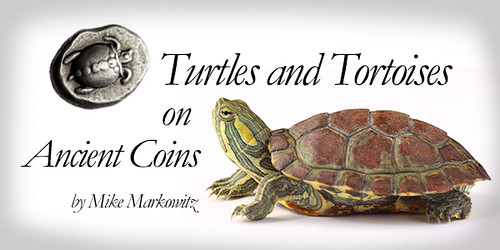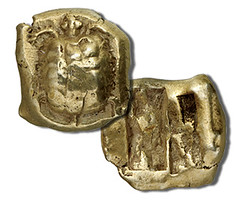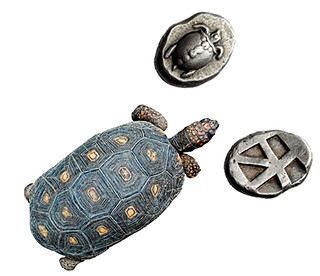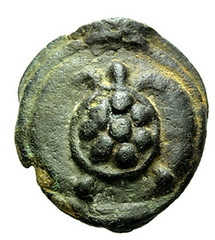
PREV ARTICLE
NEXT ARTICLE
FULL ISSUE
PREV FULL ISSUE
TURTLES AND TORTOISES ON ANCIENT COINS
Here's an excerpt from the July 28, 2016 CoinWeek column by Mike Markowitz on turtles and tortoises on ancient coins. -Editor

TURTLES ARE AQUATIC; they live mainly in water. Tortoises are terrestrial; they live mainly on land. Both were familiar to ancient people, and they figure prominently as symbols in Greek and Roman mythology, art, literature and, occasionally, on coins.
When the Swedish naturalist Carl Linnaeus (1707-1778) classified European tortoises, he named one common variety Testudo graeca (“Greek tortoise”). It appears on a rare, early electrum stater (c. 600-500 BCE) from an uncertain mint in Asia Minor. Aegina Sea Turtles
These coins bore the city’s badge: a sea turtle. Aegina traded in silver long before the invention of coinage, and one theory is that the turtle was chosen because primitive silver ingots had a rounded “turtle-back” shape. Trace element analysis indicates that the silver came from mines on the island of Sifnos (or Siphnos), about 130 km (80 miles) to the southeast. The “Aeginetan” weight standard included a didrachm or stater of 12.2 grams, a drachma of 6.1 grams, a hemidrachm or triobol of about three grams and an obol of one gram. The staters are the most common, and have been found in hoards and single finds across the ancient world, often heavily worn from circulation, slashed with test cuts and pocked with “banker’s marks” (small punches that probably validated a coin as “good” in a particular marketplace). The reverse of the coins bear a variety of geometric punch-marks: a “Union Jack” (a rectangle with intersecting lines resembling the pattern of the British flag), a “mill sail” (four triangles arranged like the sails of a windmill), and a “skew” (a cross with one diagonal line from the center). Roman Turtles
These animals rarely appear on later Roman coinage except in the form of musical instruments. There were many different sizes and varieties of the ancient stringed instrument generically called a “lyre”, but one type–the chelys–has a sound-box or “resonator” made from a tortoise shell. According to legend, the infant god Hermes invented the chelys when he crawled from the cave where he was born, killed a tortoise, and stretched seven strings across its empty shell. His half-brother Apollo was so charmed by the music that he traded his magical cattle for it, becoming the god of music. To read the complete article, see:
Wayne Homren, Editor The Numismatic Bibliomania Society is a non-profit organization promoting numismatic literature. See our web site at coinbooks.org. To submit items for publication in The E-Sylum, write to the Editor at this address: whomren@gmail.com To subscribe go to: https://my.binhost.com/lists/listinfo/esylum All Rights Reserved. NBS Home Page Contact the NBS webmaster 
|


